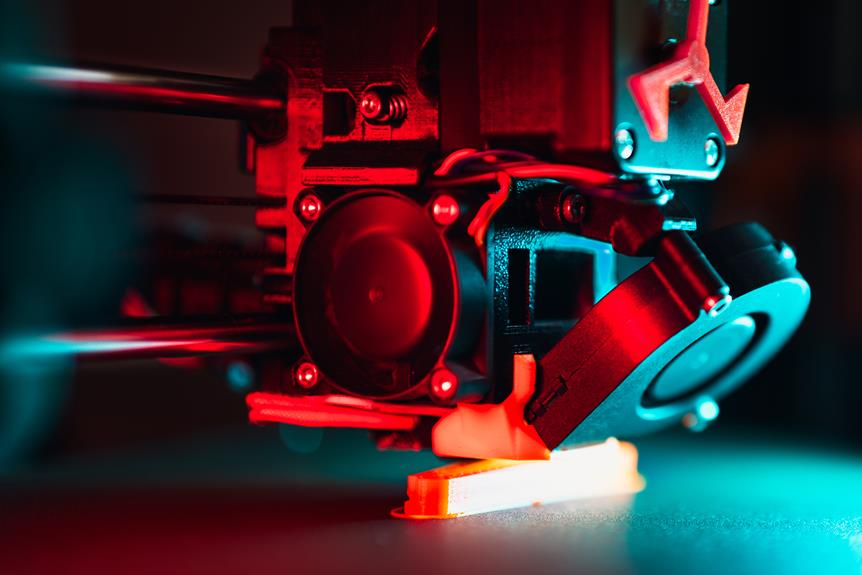Sustainability and Recycled Materials in 3D Printing: A Greener Approach
In the rapidly evolving world of 3D printing, a revolution is underway – one that promises a greener, more sustainable approach.
Imagine a future where the power of innovation meets the urgent need for environmental conservation. This article explores the exciting possibilities of sustainability and recycled materials in 3D printing, revealing how they can reshape the industry and pave the way for a more eco-friendly future.
Join us as we delve into the world of sustainable options, where liberation from wasteful practices is within reach.
Key Takeaways
- Integration of sustainability practices is crucial for the long-term environmental viability of 3D printing.
- Using recycled materials reduces waste, energy consumption, and carbon emissions associated with production.
- Sustainable materials derived from renewable sources promote a circular economy and reduce reliance on non-renewable resources.
- Closed-loop recycling systems enable the recycling and reusing of 3D printed waste and failed prints, contributing to sustainable manufacturing practices.
The Importance of Sustainability in 3D Printing
The integration of sustainability practices in 3D printing is crucial for the long-term environmental viability of the technology. As the world becomes increasingly aware of the need for sustainable solutions, it is imperative that 3D printing follows suit. By incorporating sustainability and recycled materials in 3D printing, we can significantly reduce the negative environmental impact associated with traditional manufacturing processes.
One of the key advantages of 3D printing is the ability to use a wide range of materials, including advanced materials that are more sustainable and eco-friendly. For instance, using recycled plastics instead of virgin materials not only reduces waste but also conserves valuable resources. Additionally, the use of biodegradable materials in 3D printing can further minimize the environmental footprint.
Moreover, 3D printing offers numerous opportunities for sustainable construction practices. This technology allows for the fabrication of complex structures using fewer materials and generating less waste compared to traditional construction methods. By using sustainable materials and optimizing the design and production processes, we can achieve greater energy efficiency and reduce carbon emissions.
Exploring the Environmental Benefits of Recycled Materials
By utilizing recycled materials in 3D printing, we can significantly reduce waste and contribute to a more sustainable and eco-friendly manufacturing process. The environmental benefits of using recycled materials in 3D printing are substantial and cannot be overlooked.
Firstly, the use of recycled materials helps to divert waste from landfills, reducing the amount of waste that ends up polluting our environment. This is particularly important considering the increasing amount of plastic waste that is being generated globally.
Secondly, recycling materials for 3D printing reduces the need for virgin materials, which in turn reduces the energy consumption and carbon emissions associated with their production. The manufacturing of virgin materials often involves energy-intensive processes and the release of greenhouse gases, contributing to climate change. By opting for recycled materials, we can significantly lower our carbon footprint and mitigate the environmental impact of 3D printing.
Furthermore, using recycled materials in 3D printing can also help to conserve natural resources. By repurposing and reusing materials, we can reduce the extraction of raw materials from the earth, preserving natural habitats and ecosystems.
Sustainable Materials: A Game Changer in 3D Printing
Using sustainable materials in 3D printing can revolutionize the manufacturing industry by reducing environmental impact and promoting a more responsible approach to production. Traditional manufacturing methods often rely on non-renewable resources and generate significant waste, contributing to pollution and climate change. However, the advent of sustainable materials in 3D printing opens up new possibilities for a greener future.
One of the key advantages of sustainable materials in 3D printing is their ability to be derived from renewable sources. Instead of relying on fossil fuels or other non-renewable resources, these materials can be sourced from plant-based feedstocks, such as corn or algae. By using renewable resources, 3D printing can help alleviate the strain on the environment and reduce carbon emissions.
Furthermore, sustainable materials in 3D printing can also be recyclable and biodegradable. This means that at the end of their lifecycle, these materials can be easily broken down and reused or safely returned to the environment without causing harm. This closed-loop system significantly reduces waste and promotes a more circular economy.
In addition to their environmental benefits, sustainable materials also offer unique properties that can enhance the capabilities of 3D printed products. For example, bio-based materials can be lightweight yet strong, making them ideal for applications in aerospace or automotive industries. By harnessing the potential of sustainable materials, 3D printing can enable the creation of innovative and high-performance products.
How Recycled Materials Revolutionize the 3D Printing Industry
Recycled materials are revolutionizing the 3D printing industry by transforming waste into valuable resources and promoting a more sustainable approach to manufacturing. With the growing concern over environmental sustainability, the use of recycled materials in 3D printing has gained significant attention and traction.
One of the key advantages of using recycled materials in 3D printing is the reduction in waste generation. By repurposing and reusing materials that would otherwise end up in landfills, the industry is able to minimize its environmental impact. This not only conserves natural resources but also reduces energy consumption and carbon emissions associated with the extraction and production of new materials.
Furthermore, the use of recycled materials in 3D printing offers economic benefits. It reduces the reliance on expensive raw materials and opens up opportunities for cost-effective production. This can be particularly beneficial for small businesses and individuals who may have limited budgets for material acquisition.
In addition to the environmental and economic advantages, the use of recycled materials in 3D printing also encourages innovation and creativity. With a wide variety of materials available for recycling, designers and manufacturers can explore new possibilities and push the boundaries of what can be achieved with 3D printing.
Embracing a Greener Future: Sustainable Options in 3D Printing
Three sustainable options are available in 3D printing to embrace a greener future and promote environmentally friendly manufacturing practices. These options include biodegradable materials, eco-friendly filaments, and closed-loop recycling systems.
Biodegradable materials are a great choice for sustainable 3D printing as they break down naturally without causing harm to the environment. PLA (polylactic acid) is one such material that is derived from renewable resources like cornstarch or sugarcane, making it an eco-friendly alternative to traditional plastics. It is widely used in various applications such as packaging, medical devices, and consumer products.
Eco-friendly filaments are another sustainable option in 3D printing. These filaments are made from recycled materials, reducing the need for virgin plastics. Companies like Filamentive and Refil offer filaments made from recycled PET bottles and other waste materials. By using these filaments, manufacturers can reduce their carbon footprint and contribute to a circular economy.
Closed-loop recycling systems are an innovative approach to sustainable 3D printing. These systems enable the recycling and reusing of 3D printed waste and failed prints. Companies like Filabot and ReDeTec have developed machines that grind and extrude these materials back into usable filaments. This not only reduces waste but also saves costs and resources.
By adopting these sustainable options in 3D printing, manufacturers can contribute to a greener future and promote environmentally friendly manufacturing practices. The table below provides a summary of these sustainable options:
| Sustainable Option | Description |
|---|---|
| Biodegradable materials | Materials that break down naturally without harming the environment, such as PLA derived from renewable resources. |
| Eco-friendly filaments | Filaments made from recycled materials, reducing the need for virgin plastics. |
| Closed-loop recycling systems | Machines that recycle and reuse 3D printed waste and failed prints, reducing waste and saving costs and resources. |
Frequently Asked Questions
What Are the Limitations of Using Recycled Materials in 3D Printing?
The limitations of using recycled materials in 3D printing are primarily related to the quality and consistency of the materials. Recycled materials may have impurities or variations in composition, which can affect the printability and strength of the final product.
Are There Any Regulations or Certifications for Sustainable 3D Printing Materials?
Are there any regulations or certifications for sustainable 3D printing materials? Ensuring the eco-friendliness of 3D printing materials has become a priority in the industry. Consequently, various organizations and standards have emerged to certify sustainable practices and materials in 3D printing.
How Does the Cost of Using Recycled Materials Compare to Traditional Materials in 3D Printing?
The cost of using recycled materials in 3D printing compared to traditional materials largely depends on the specific materials being used and their availability. However, in general, recycled materials can offer cost savings due to their lower production and processing costs.
What Are the Challenges in Sourcing Sufficient Quantities of Recycled Materials for 3D Printing?
The challenge in sourcing sufficient quantities of recycled materials for 3D printing lies in the limited availability and variability of these materials. This poses difficulties in ensuring consistent quality and meeting the demand for sustainable options in the industry.
Can the Quality and Performance of 3D Printed Objects Be Compromised When Using Recycled Materials?
When using recycled materials in 3D printing, there is a potential compromise in the quality and performance of the printed objects. Factors such as material degradation, inconsistent composition, and limited mechanical properties can affect the final outcome.
Conclusion
In conclusion, sustainability and the use of recycled materials in 3D printing offer significant environmental benefits and have the potential to revolutionize the industry.
By embracing greener options, we can contribute to a more sustainable future.
The integration of sustainable materials in 3D printing is a game changer, providing innovative solutions that reduce waste and promote eco-friendly practices.
With continued advancements in this field, we can create a more sustainable and efficient 3D printing industry, paving the way for a greener future.









